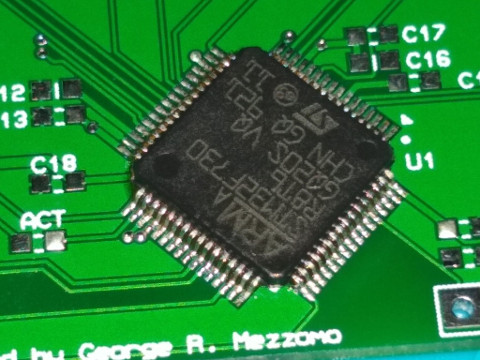-
Notifications
You must be signed in to change notification settings - Fork 98
F7 v1 Assembly
NOTE: If you received a pre-assembled adapter then you can skip straight to Hardware Setup.
You should obtain (or have received) the following parts, in addition to the Greaseweazle PCB. Note that kits may include an excess quantity of the "passives" (resistors, capacitors).
| Board Reference | Footprint | Value/Type | Quantity |
|---|---|---|---|
| C1-C2,C12 | 0603 | 10uF | 3 |
| C3,C5-C8,C10-C11,C13-C15,C17-C18 | 0603 | 100nF | 12 |
| C4,C9,C16 | 0603 | 1uF | 3 |
| C19-C20 | 0603 | 27pF | 2 |
| R1-R4 | 06031 | 1k | 4 |
| R5 | 0603 | 10k | 1 |
| R6 | 0603 | 1k | 1 |
| R7-R8 | 0603 | 470R | 2 |
| U1 | LQFP64 | STM32F730R8 | 1 |
| U2 | SOT25 | AP2112K-3 | 1 |
| ACT,PWR | 0603 | LED | 2 |
| BOOT | 2x1 | Pin Header | 1 |
| DEBUG | 5x12 | Pin Header | 1 |
| UART | 4x1 | Pin Header | 1 |
| FLOPPY POWER | 4x1 | TE 171826-4 | 1 |
| FLOPPY DATA | 17x2 | Box Header | 1 |
| USB | USB-B | 1 | |
| X1 | HC-49/US | 8MHz | 1 |
- PCB Rev 1: R1-R4 are 0402 footprint
- PCB Rev 1: DEBUG header is 4x1 pins
Please note that the small size and pitch of some components, particularly U1, means that you will need some soldering proficiency, and equipment such as the following:
- A workbench with decent lighting
- Moderate magnification (eg. a magnifying bench light)
- Good quality leaded (60/40) solder (eg. Stannol, Kester)
- Avoid lead-free solder!
- Plenty of flux
- Tweezers
Although not a step-by-step guide, I will note some caveats.
-
The kit comes with the STM32 chip placed in a fold of antistatic material, taped to the PCB. Be warned, the chip will be loose when you peel the tape!
-
The kit-supplied LEDs are manufacturer codes HSMS-C190 and HSMY-C190. The cathode terminal is marked by a tiny dot, and should be oriented towards the right-hand side of the PCB (ie. under the R of PWR, and the T of ACT). You can find the manufacturer datasheet here.
-
[Rev 1 PCB only] The USB-B pin spacing is slightly too wide on the PCB. You will need to splay the four pins of the USB connector slightly to make them fit. Push the connector firmly down onto the PCB only when you are sure the pins are all correctly located.
-
You may wish to remove pin 5 and/or pin 3 from the FLOPPY DATA header. Some floppy-drive cables use one of these pins as an orientation key.
